Recently I was asked to
review a new set of plug-ins for FCP devised by Sydney cinematographer
Ben Allen (ACS). But the way I figure it, you don't really
want to know whether I think a product is great. After all, who
the hell am I anyway? Why should you care what I think?
What you really want to know, what I
always want to know, is how I use this thing, and how can it
make my work, and therefore my life, easier.
So I thought that instead of a review,
I would write a tutorial on how to repair and style your colour
in FCP using the plug-in set 'The Grading Sweet'.
The Grading Sweet can be purchased as
two separate packages - the Standard set or the Pro suite, or
all together as a unit known as the Grading Sweet Pro.
The Standard Sweet package contains the
filters Colour Kit, Colour Temperature, CrimeScene, DayForNight,
Exposure Corrector, Highlights, Vignette and Sweetener, which
is all the filters you are likely to need up to a quite serious
level.
The Pro additions set contains filters
that you would more likely need if you were part of a professional
workflow, with filters such as Pro Airbrush, Pro Bleach-Bypass,
Pro Window and Pro Workprint.
Starting with the standard set, lets
first look at repairing this rather awkward clip.

A tip here is that when working on colour in FCP it's a good
idea to invoke the Colour Correction Window set-up, which you
can find under Window > Arrange Colour Correction or Dual
Screen Colour Correction. This will open an extra set of windows
at the top right that contain your video scopes and the frame
viewer, which can give you a live split-screen update of your
picture before and after any effects have been applied.
Also, it's very important to have a broadcast
video monitor, or at the very least a television to view your
work on when manipulating colour. Computer monitors do not accurately
represent video brightness or colour, so in all likelihood any
adjustments you make using them as a guide will be wrong for
television. The exception to this rule is, of course, if you
are grading for the internet, or for any final production that
will be viewed on a computer screen, such as an art installation.
Getting back to the job at hand, as you
can see there are a number of problems with this picture. Firstly,
if you look at the whites in the foreground in the arrow sign,
you can see that they are too blue.
Secondly, the foreground of the picture
is underexposed. But you can see from the bright background that
if the camera operator had exposed it correctly, the background
would have become completely overexposed. As it is, it's already
a tad too bright for broadcast, which I can tell by turning on
my range check under View > Range Check > Excess Luma.
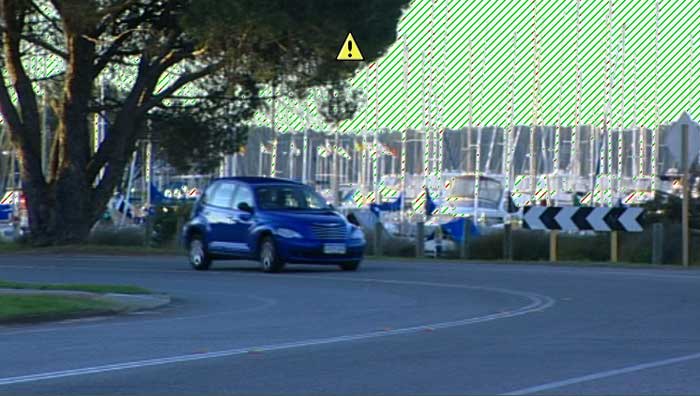
The yellow triangle tells me that the
whites exceed legal limits, and the red and green zebra stripes
show me the areas that are a problem.
So. How can we correct this clip so that
it's the right colour and correctly exposed, without getting
into problems with the very bright background?
From the Grading Sweet the first filter
I am going to apply is the Sweet Colour Temperature filter.
As you can see it's a nice simple interface with three choices
for correcting the white balance - daylight to tungsten, neutral,
and tungsten to daylight.

Putting it basically, this works in a
similar way to white balancing your camera for indoor or outdoor
light. Selecting daylight to tungsten will make your picture
more orange, and tungsten to daylight will make it more blue.
If I select daylight to tungsten I get
this result.

Which interestingly is quite close to
this hand corrected version that I did for comparison, but took
only one click.

As you can see in the frame viewer here this is an immediate
improvement on the colour temperature.

So now on to the exposure. I'm just going
to ignore the background for the moment and concentrate on getting
the foreground better exposed. From the Grading Sweet I select
Sweet Exposure, click 'Underexposed' and knock it up two stops.
The filter gives you a range of up to 8 stops both in underexposure
and overexposure, so there's a ton of room for improvement.

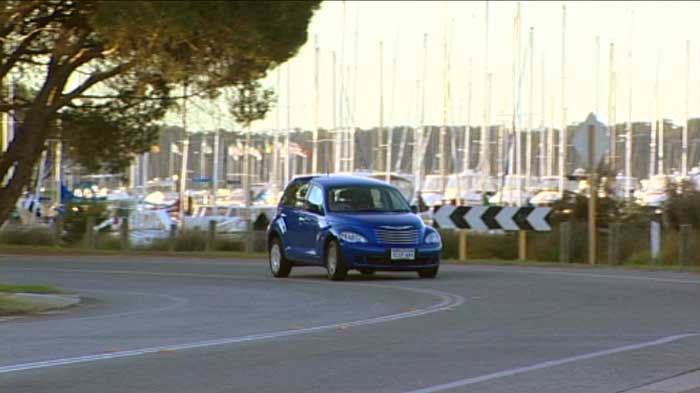
Next, because I can, I'm going to add
a filter known as the 'Sweetener', to see what it does.
The manual indicates that it 'Adds "richness" to any
image' using a 'proprietary lookup table to enhance images'.
Certainly sounds interesting.
After a bit of fiddling I settled for
30% intensity and I actually quite like what it does. In this
picture the vision on the right hand side has been 'sweetened'.
You can see that some of the dull wash has been removed, leaving
the picture looking crisper. Nice.

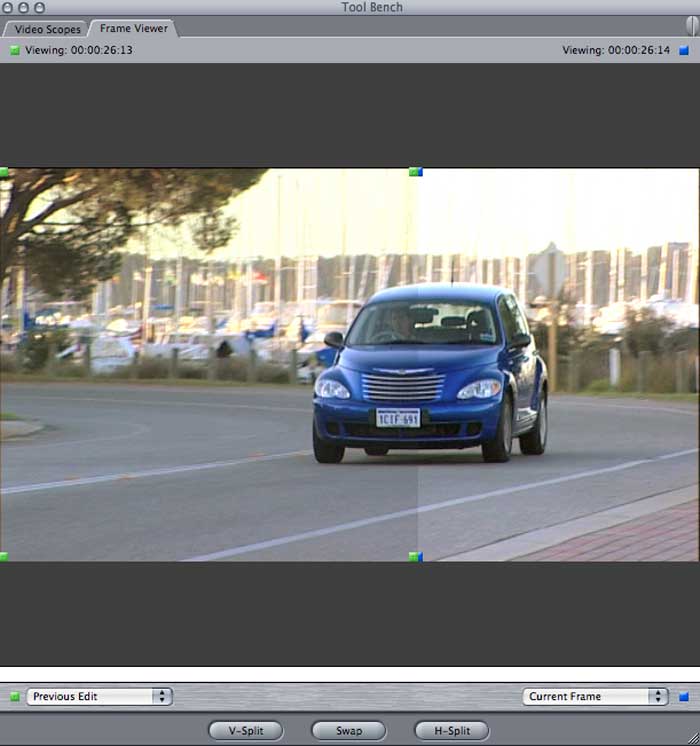
So the foreground is looking a lot better,
but, as I suspected, now the background is even worse. The areas
in red here are outside legal broadcast limits, and that means
that this picture would be rejected for broadcast. So it's got
to be dealt with.
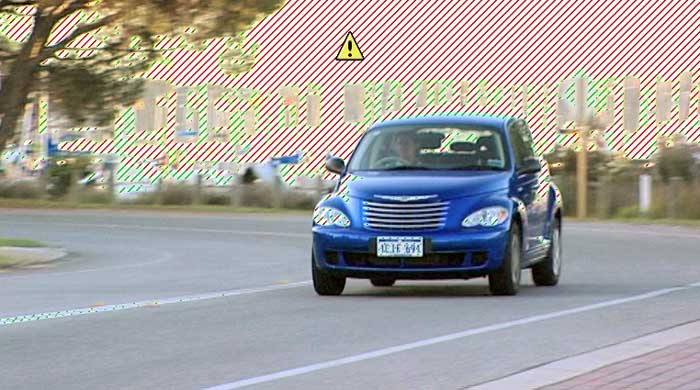
You can selectively darken parts of images
inside FCP, but it requires time, patience and a tidy matte technique.
Simply put, it's fiddly and the results (at least for me) are
often not perfect. Luckily for me, in the Pro section of the
Grading Sweet, there's a handy dandy filter called the Pro
Window.
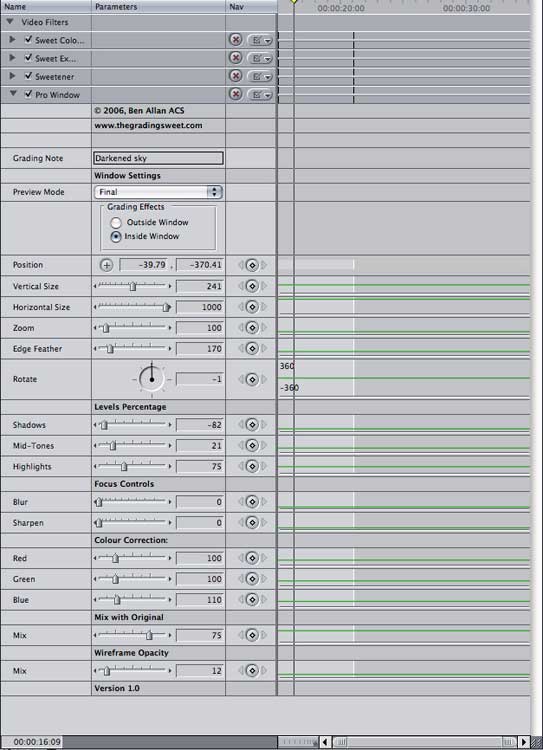
OK, yes, this one looks a lot more complicated
than the previous filters, but looking at it step by step, it's
all pretty self explanatory.
First of all there's the grading note
window, which is a welcome addition because as anyone who
does composites knows, once you start stacking effects it gets
hard to remember what function each one is performing. You can
stack pro windows to selectively work with several sections of
the same image. So in here I've just made a note to myself that
this is the Pro Window I'm using to reduce the brightness of
the sky.
The Preview mode has three settings -
Preview - which shows the outline of your circular window, final,
which is your final result, and render with frame, which presents
the preview during animation, as the Pro window is fully keyframeable.
The green area here shows the outline of the window in preview
mode.

You can choose to have the effects work
inside the window or outside it, which is also great for instances
like blurring out a background, leaving the foreground selection
in focus. In this case I'm going to work inside the window, selecting
the sky.
I can set the position and size of the
window with a combination of selections from the position, size,
zoom and edge feather sliders. Here I have the horizontal size
set as wide as it will go and the vertical size at 80 to get
a short wide window that matches the shape of the sky. With zoom
at 100, edge feather set to 70, and the position adjusted by
clicking the small cross next to the position slider and moving
it around on the canvas until I am satisfied, I get this kind
of window.
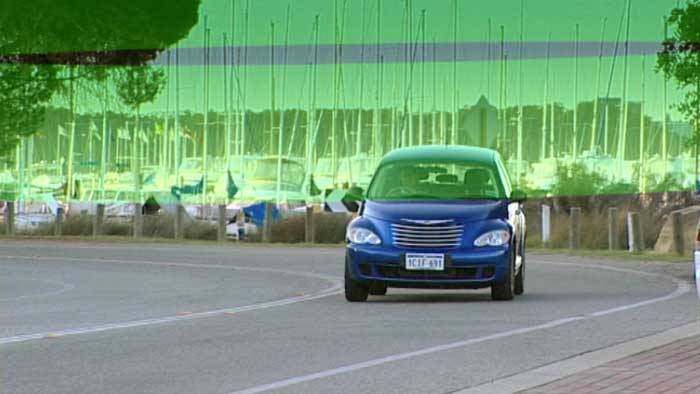
The width of the green overlay shows
the amount of feathering that is being applied. The extensive
feathering range gives an excellent blend from the adjusted vision
to the unadjusted vision, to the point of seamlessness, which
is very similar to the functions of high end colour grading systems.
You can also rotate the window to get a closer fit to an object
in your image.
Next is the important bit for this image.
The levels. I want to greatly reduce the brightness of the area
inside the window, so I start by pulling down the midtones. This
picture was a bit of a mess overall so I pulled down the shadows
and some of the highlights too, until the picture finally got
legal. While I was at it I added a bit of colour back into the
sky with the colour correction sliders.
Sadly this looks quite muddy on a computer
screen, even though it's fine inside FCP, which is why you should
always do colour correction with a broadcast monitor attached.
The green tick on the screen tells me that now it's not going
to get the show rejected.
I've included a second picture that has
been adjusted for the web, which is overexposed and looks washed
out in FCP, but approximates what it actually looks like here
on my TV.


And now I'm pretty happy. You can see
in the (web version) frame viewer that the before and after shots
are like chalk and cheese. And best of all, it took me only a
few minutes, even without having ever used the filters before.

So, great. You can do colour repair.
But what about styling, I hear you say. I want that grungy hospital
green and that lovely golden glow, you say. Well, yeah. So do
I. And most of the time I want them fast, too.
So of course I'm excited to see filters
with names like Colour Kit, CrimeScene and DayForNight
in this package.
I decided for this section to first work
on some mini-dv footage shot by my cousin while on holiday in
Europe, just to give myself a worst case scenario. So these pictures
are from a one chip camera shot by an amateur with only natural
lighting.

Again, it's difficult to show correct
broadcast images here on the web, so the following pictures will
be adjusted for computer screens, not television.
OK. Let's see what the Colour Kit has
to offer.
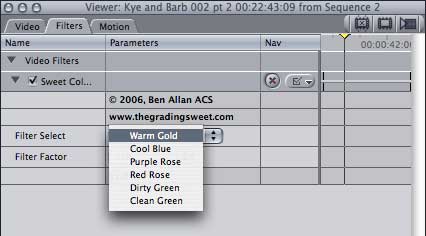
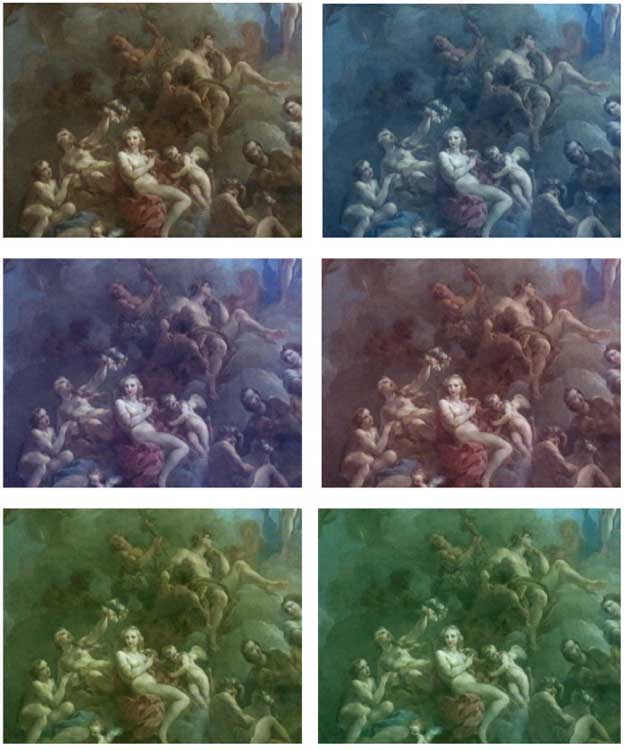
Each of these styles was achieved with
just one click, and what's more, there are six saturation levels
for each colour style. So, for example, you can add 'Warm Gold'
to your pictures and keep ramping up the intensity until you
are almost at sepia like this.
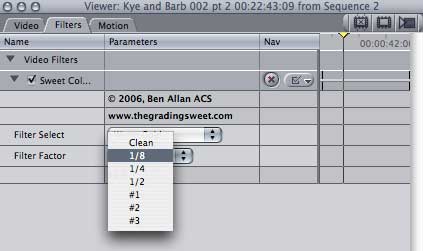

This is good news for those of us on
tight deadlines, since actually deciding on and setting up styles
is often what takes the longest. You can just say to your Producer
or Director, 'What about this look?'(click). No? Then what about
this?'(click), and go from there.
I've also found that if you add some
primary colour correction to your pictures first, the results
are even nicer, and can be individually manipulated.
The standard kit also includes a Day
for Night filter, which has several options for the kind
of feel you want. Here's a simple daylight clip with one of each
of the three options - Blue, Silver, and Blue-Green - applied.
These pictures, by the way, are from a 16mm shoot TK'd to DVCAM
(Bestlight).


The simplicity of these filters makes
them especially good for novice colourists, who know where they
want to go, but are often not quite sure how to get there.
The same goes for the CrimeScene filters,
which add quick and simple preset styles to your work. Just add
the filter, choose a style, then adjust the intensity to your
liking.

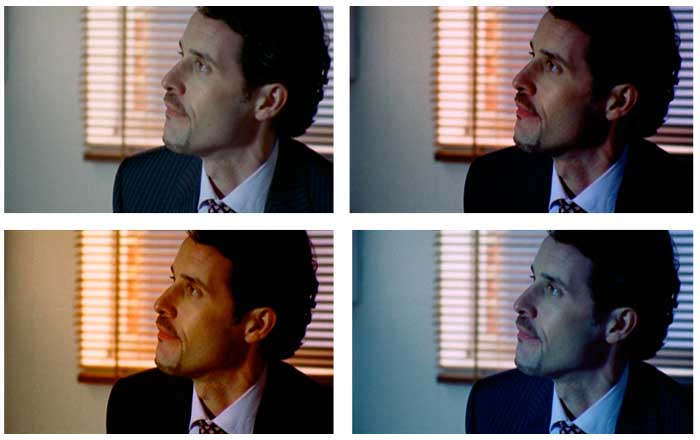
The last two items in the standard pack
are the Sweet Vignette and the Sweet Highlighter.
The Vignette acts as a scaled down version
of the Pro Window from the Pro kit, giving you the ability to
darken or lighten an area inside a feathered window. The controls
are essentially the same as the Pro Window's, including that
nice wide edge featherer.
As you can see from my cousin's mini-dv
shot of the Eiffel Tower, a good vignette can add a lot of visual
interest. In this instance I also applied the Sweetener filter
to increase the contrast to add to the effect.


The effects of the Highlighter are much
more subtle. Most commonly it would be used to soften the highlights
to take some of the harsh 'video' feel out of the picture, but
it could also be used to add a misty 'romantic' softening.
Using the View menu on the filter I am
able to access the matte view of what I am selecting, which you
can see in picture two below. Here I have used the range to select
the range of whites I want to include in the effect, and the
trim and feather to expand (or reduce) and soften the area affected.
The Blend slider controls how strong the effect will be.
Picture three shows the result of the
filter, but, as I said, this is fairly subtle, even though I
have gone a bit overboard to make it more obvious. Picture four
is probably the best example to look at, where the left hand
side is unaffected, and the right hand side has been softened.
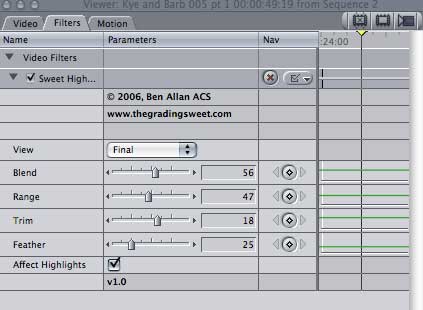

And that concludes our tour of Europe,
and the Grading Sweet package. If you are in a more professional
workflow situation, you might want to also check out the Pro
Kit which has some great filters such as the Pro Workprint
which basically mimics a film printer with Red, Green and Blue
lights, as well as actually stamping the footage with all the
relevant information.
Also, I've personally become quite addicted
to the Pro Window. It's an excellent fast way to isolate and
adjust parts of your picture without the need for layering and
blending copies.
I hope this tutorial has helped you to
understand the possibilities and benefits of even simple colour
work a little better. And I hope it's helped you to be less afraid
of messing with it. Make a copy of your project and start playing.
Because that's the greatest thing about digital editing - even
if you make an almighty mess, you can always press undo.
For more information on The Grading Sweet,
check out their website at http://www.thegradingsweet.com/main/HOME.html
My thanks to Black Olive, Kye
Hammond and Vic Miraudo for their kind permission
to use the images featured in this tute.
copyright©JudeCotter
2006
Jude Cotter lives and works in the wilds of Western
Australia as a freelance broadcast editor, FCP trainer and trouble-shooter.